Research Proposal: Prefabrication of Domestic Structures
VerifiedAdded on 2023/01/23
|17
|3862
|91
Report
AI Summary
This research proposal investigates the prefabrication and industrialization of domestic structures within the UK context. It aims to analyze the feasibility, sustainability, and practical applicability of prefabrication methods, considering their advantages over traditional construction techniques. The study will employ primary and secondary research to address research questions concerning the contribution of modular construction to sustainable housing, the sustainability benefits of prefabrication compared to traditional methods, and the ways prefabrication can enhance sustainable housing in the UK. The proposal includes a literature review examining the efficiency and sustainability of prefabricated modular units, addressing issues such as cost savings, reduced waste, and environmental benefits. It also acknowledges the challenges faced by prefabrication in the UK, including social mistrust, limited design flexibility, and the need for incremental innovation. The research is expected to provide insights into the potential of prefabrication to improve the efficiency, sustainability, and overall performance of domestic structures in the UK.
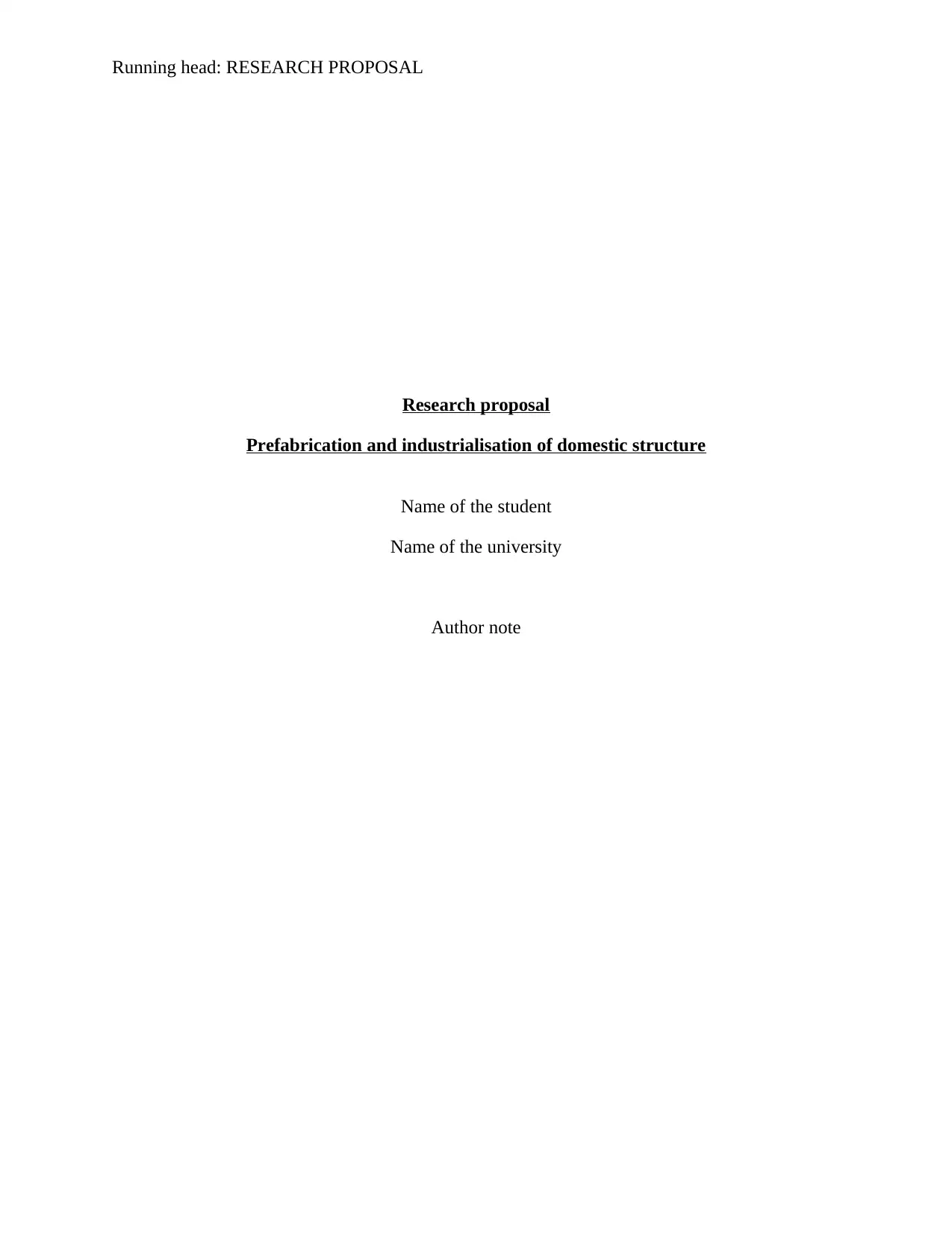
Running head: RESEARCH PROPOSAL
Research proposal
Prefabrication and industrialisation of domestic structure
Name of the student
Name of the university
Author note
Research proposal
Prefabrication and industrialisation of domestic structure
Name of the student
Name of the university
Author note
Paraphrase This Document
Need a fresh take? Get an instant paraphrase of this document with our AI Paraphraser
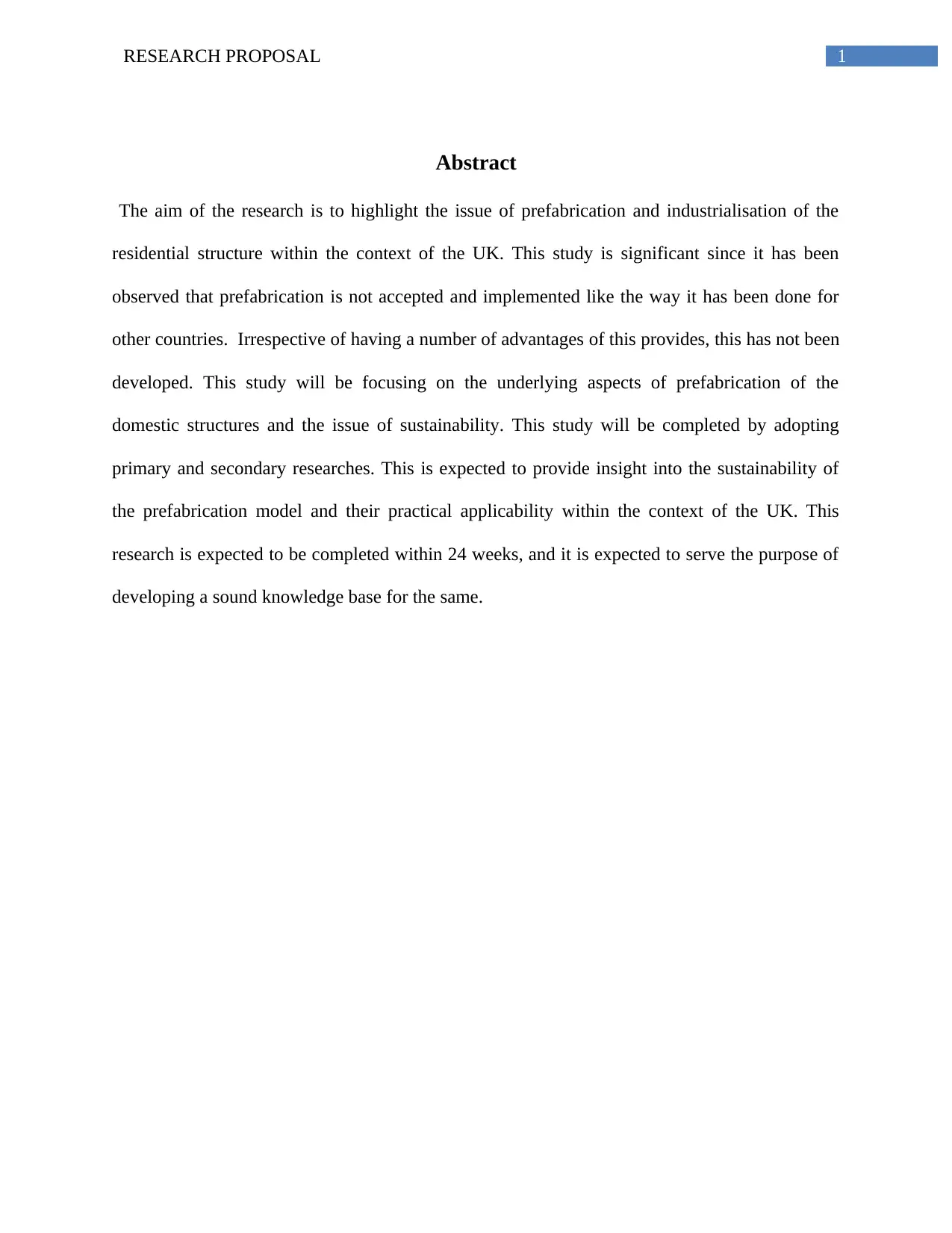
1RESEARCH PROPOSAL
Abstract
The aim of the research is to highlight the issue of prefabrication and industrialisation of the
residential structure within the context of the UK. This study is significant since it has been
observed that prefabrication is not accepted and implemented like the way it has been done for
other countries. Irrespective of having a number of advantages of this provides, this has not been
developed. This study will be focusing on the underlying aspects of prefabrication of the
domestic structures and the issue of sustainability. This study will be completed by adopting
primary and secondary researches. This is expected to provide insight into the sustainability of
the prefabrication model and their practical applicability within the context of the UK. This
research is expected to be completed within 24 weeks, and it is expected to serve the purpose of
developing a sound knowledge base for the same.
Abstract
The aim of the research is to highlight the issue of prefabrication and industrialisation of the
residential structure within the context of the UK. This study is significant since it has been
observed that prefabrication is not accepted and implemented like the way it has been done for
other countries. Irrespective of having a number of advantages of this provides, this has not been
developed. This study will be focusing on the underlying aspects of prefabrication of the
domestic structures and the issue of sustainability. This study will be completed by adopting
primary and secondary researches. This is expected to provide insight into the sustainability of
the prefabrication model and their practical applicability within the context of the UK. This
research is expected to be completed within 24 weeks, and it is expected to serve the purpose of
developing a sound knowledge base for the same.
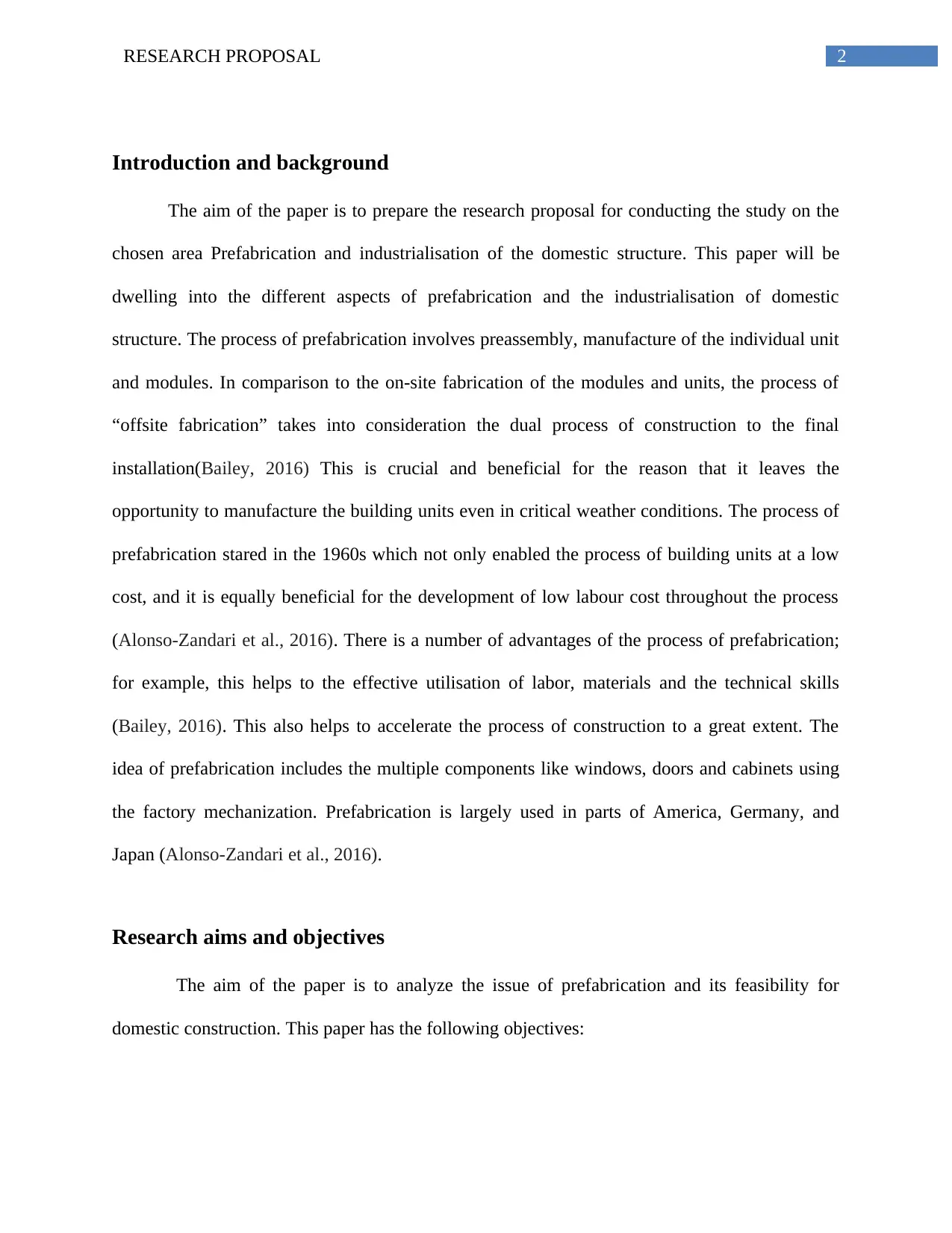
2RESEARCH PROPOSAL
Introduction and background
The aim of the paper is to prepare the research proposal for conducting the study on the
chosen area Prefabrication and industrialisation of the domestic structure. This paper will be
dwelling into the different aspects of prefabrication and the industrialisation of domestic
structure. The process of prefabrication involves preassembly, manufacture of the individual unit
and modules. In comparison to the on-site fabrication of the modules and units, the process of
“offsite fabrication” takes into consideration the dual process of construction to the final
installation(Bailey, 2016) This is crucial and beneficial for the reason that it leaves the
opportunity to manufacture the building units even in critical weather conditions. The process of
prefabrication stared in the 1960s which not only enabled the process of building units at a low
cost, and it is equally beneficial for the development of low labour cost throughout the process
(Alonso-Zandari et al., 2016). There is a number of advantages of the process of prefabrication;
for example, this helps to the effective utilisation of labor, materials and the technical skills
(Bailey, 2016). This also helps to accelerate the process of construction to a great extent. The
idea of prefabrication includes the multiple components like windows, doors and cabinets using
the factory mechanization. Prefabrication is largely used in parts of America, Germany, and
Japan (Alonso-Zandari et al., 2016).
Research aims and objectives
The aim of the paper is to analyze the issue of prefabrication and its feasibility for
domestic construction. This paper has the following objectives:
Introduction and background
The aim of the paper is to prepare the research proposal for conducting the study on the
chosen area Prefabrication and industrialisation of the domestic structure. This paper will be
dwelling into the different aspects of prefabrication and the industrialisation of domestic
structure. The process of prefabrication involves preassembly, manufacture of the individual unit
and modules. In comparison to the on-site fabrication of the modules and units, the process of
“offsite fabrication” takes into consideration the dual process of construction to the final
installation(Bailey, 2016) This is crucial and beneficial for the reason that it leaves the
opportunity to manufacture the building units even in critical weather conditions. The process of
prefabrication stared in the 1960s which not only enabled the process of building units at a low
cost, and it is equally beneficial for the development of low labour cost throughout the process
(Alonso-Zandari et al., 2016). There is a number of advantages of the process of prefabrication;
for example, this helps to the effective utilisation of labor, materials and the technical skills
(Bailey, 2016). This also helps to accelerate the process of construction to a great extent. The
idea of prefabrication includes the multiple components like windows, doors and cabinets using
the factory mechanization. Prefabrication is largely used in parts of America, Germany, and
Japan (Alonso-Zandari et al., 2016).
Research aims and objectives
The aim of the paper is to analyze the issue of prefabrication and its feasibility for
domestic construction. This paper has the following objectives:
⊘ This is a preview!⊘
Do you want full access?
Subscribe today to unlock all pages.

Trusted by 1+ million students worldwide
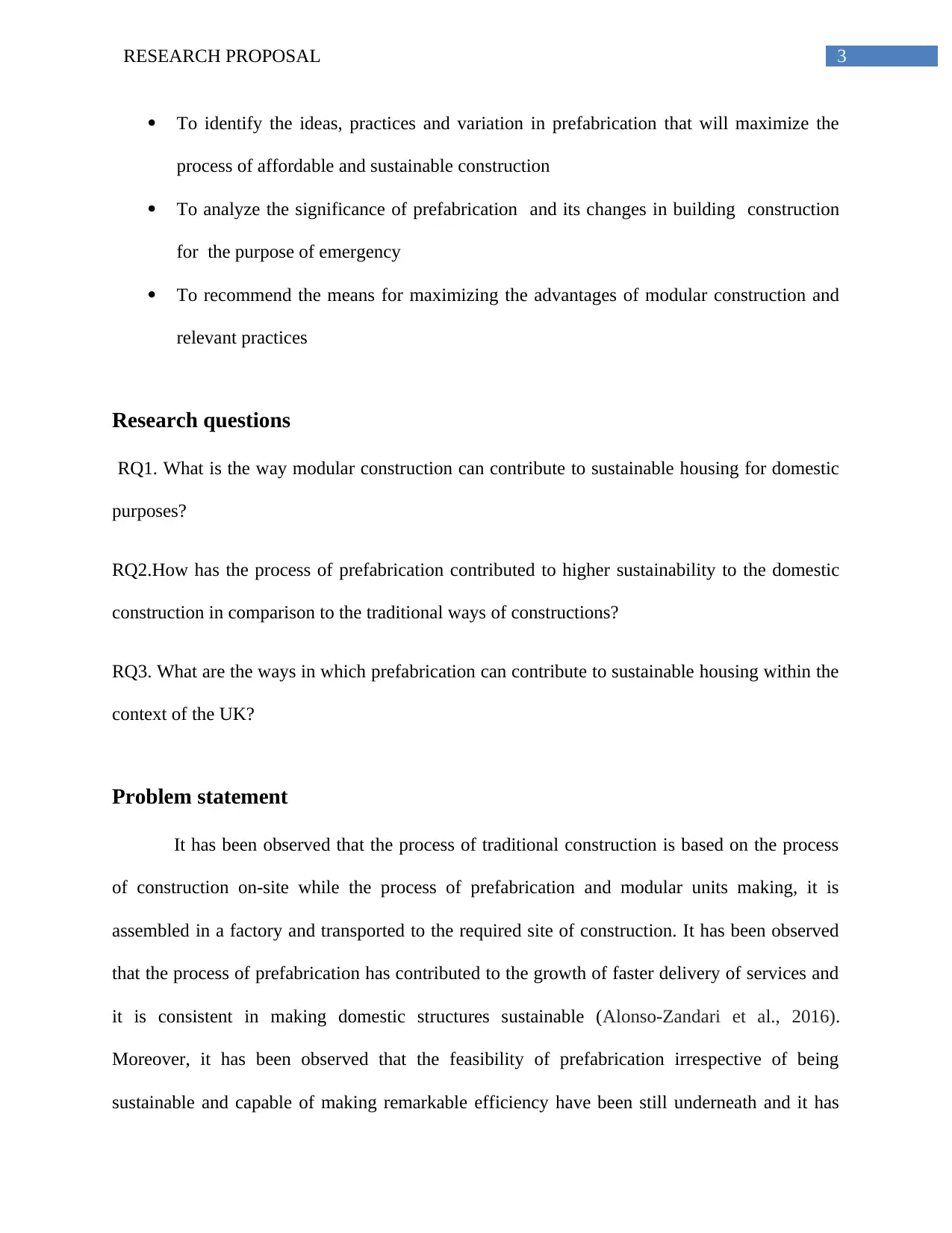
3RESEARCH PROPOSAL
To identify the ideas, practices and variation in prefabrication that will maximize the
process of affordable and sustainable construction
To analyze the significance of prefabrication and its changes in building construction
for the purpose of emergency
To recommend the means for maximizing the advantages of modular construction and
relevant practices
Research questions
RQ1. What is the way modular construction can contribute to sustainable housing for domestic
purposes?
RQ2.How has the process of prefabrication contributed to higher sustainability to the domestic
construction in comparison to the traditional ways of constructions?
RQ3. What are the ways in which prefabrication can contribute to sustainable housing within the
context of the UK?
Problem statement
It has been observed that the process of traditional construction is based on the process
of construction on-site while the process of prefabrication and modular units making, it is
assembled in a factory and transported to the required site of construction. It has been observed
that the process of prefabrication has contributed to the growth of faster delivery of services and
it is consistent in making domestic structures sustainable (Alonso-Zandari et al., 2016).
Moreover, it has been observed that the feasibility of prefabrication irrespective of being
sustainable and capable of making remarkable efficiency have been still underneath and it has
To identify the ideas, practices and variation in prefabrication that will maximize the
process of affordable and sustainable construction
To analyze the significance of prefabrication and its changes in building construction
for the purpose of emergency
To recommend the means for maximizing the advantages of modular construction and
relevant practices
Research questions
RQ1. What is the way modular construction can contribute to sustainable housing for domestic
purposes?
RQ2.How has the process of prefabrication contributed to higher sustainability to the domestic
construction in comparison to the traditional ways of constructions?
RQ3. What are the ways in which prefabrication can contribute to sustainable housing within the
context of the UK?
Problem statement
It has been observed that the process of traditional construction is based on the process
of construction on-site while the process of prefabrication and modular units making, it is
assembled in a factory and transported to the required site of construction. It has been observed
that the process of prefabrication has contributed to the growth of faster delivery of services and
it is consistent in making domestic structures sustainable (Alonso-Zandari et al., 2016).
Moreover, it has been observed that the feasibility of prefabrication irrespective of being
sustainable and capable of making remarkable efficiency have been still underneath and it has
Paraphrase This Document
Need a fresh take? Get an instant paraphrase of this document with our AI Paraphraser

4RESEARCH PROPOSAL
not been explored to a great extent. This has been identified that the process of prefabrication
and its sustainable practices have not given required consideration which has resulted into the
lack of research in this field, this paper is an analysis of understanding the nuances of
prefabrication in ensuring sustainability and efficiency within the context of UK domestic
structure.
Literature review
Efficiency and sustainability of prefabrication of the modular units
This has been observed that the process of building construction can be divided into four
prominent parts, the substructure, frame, envelope and internal works (Killian et al., 2015). This
process can again be subdivided into multiple parts for the purpose of making it feasible and
easier. This has been one of the aspects where the idea of prefabrication can be implemented. It
is also crucial to remember that all types of construction have different priorities where off-site
construction can come into help. This will be helpful in using the skill of labour in a more
productive way, and materials can be utilized under controlled condition. This leads to the
process of high-grade production (Killian et al., 2015). Moreover, it is also crucial to consider
that on an average of 10% of cost savings with a 5 % reduction of re-work. This also helps in
increased safety and reduces the hazards of up to 16% (Heffernan et al., 2015). The
developments of prefabricated units are high in quality since it allows the scope of standardized
checks for each of the units. The advantage of prefabricated units leads to the organized
workplace and most importantly it is low waste generation (Killian et al., 2015). However, it is
not to deny the fact that there is a number of limitations associated with this process. One of the
issues of this prefabricated process of assembly is the size of units, site accessibility and level of
not been explored to a great extent. This has been identified that the process of prefabrication
and its sustainable practices have not given required consideration which has resulted into the
lack of research in this field, this paper is an analysis of understanding the nuances of
prefabrication in ensuring sustainability and efficiency within the context of UK domestic
structure.
Literature review
Efficiency and sustainability of prefabrication of the modular units
This has been observed that the process of building construction can be divided into four
prominent parts, the substructure, frame, envelope and internal works (Killian et al., 2015). This
process can again be subdivided into multiple parts for the purpose of making it feasible and
easier. This has been one of the aspects where the idea of prefabrication can be implemented. It
is also crucial to remember that all types of construction have different priorities where off-site
construction can come into help. This will be helpful in using the skill of labour in a more
productive way, and materials can be utilized under controlled condition. This leads to the
process of high-grade production (Killian et al., 2015). Moreover, it is also crucial to consider
that on an average of 10% of cost savings with a 5 % reduction of re-work. This also helps in
increased safety and reduces the hazards of up to 16% (Heffernan et al., 2015). The
developments of prefabricated units are high in quality since it allows the scope of standardized
checks for each of the units. The advantage of prefabricated units leads to the organized
workplace and most importantly it is low waste generation (Killian et al., 2015). However, it is
not to deny the fact that there is a number of limitations associated with this process. One of the
issues of this prefabricated process of assembly is the size of units, site accessibility and level of
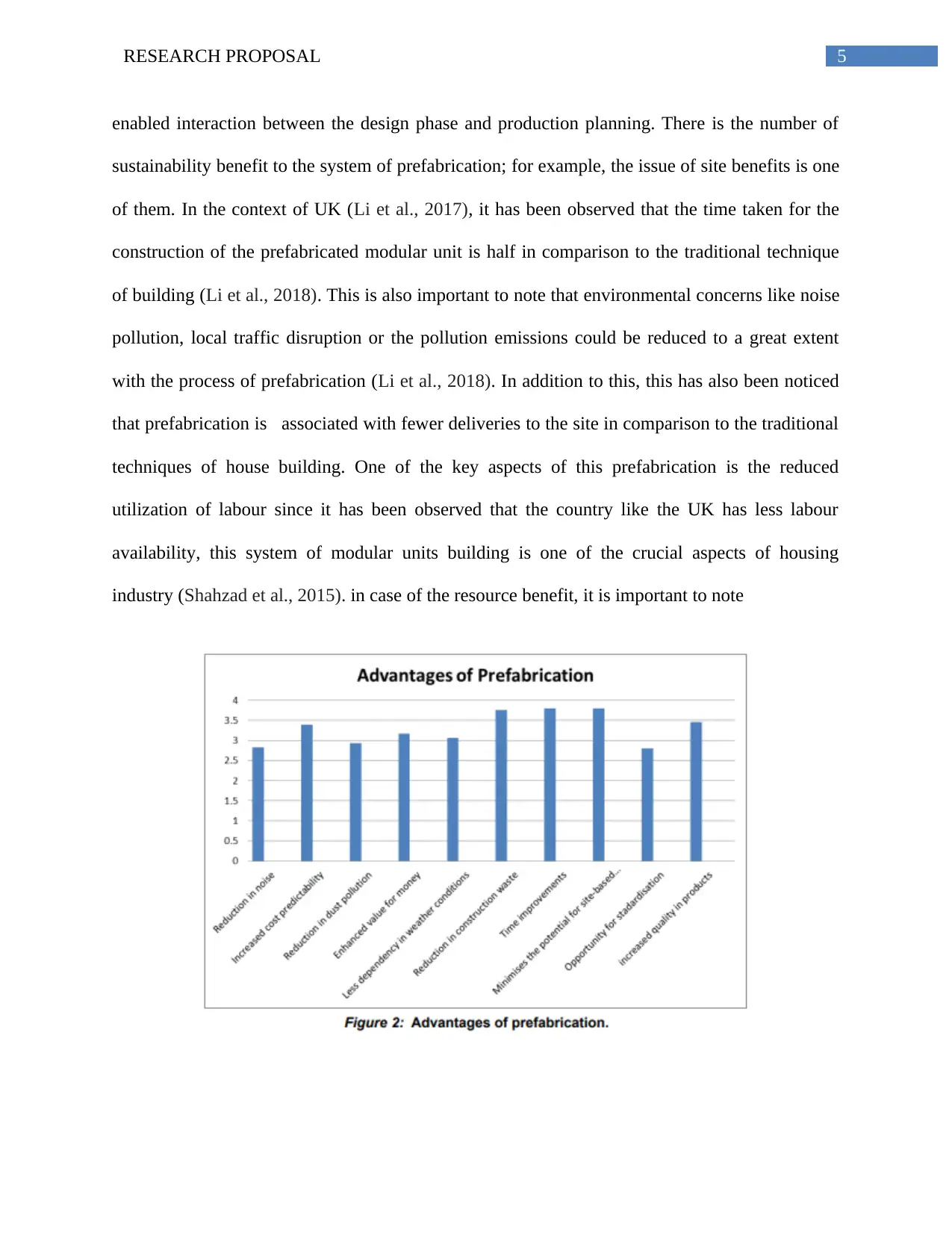
5RESEARCH PROPOSAL
enabled interaction between the design phase and production planning. There is the number of
sustainability benefit to the system of prefabrication; for example, the issue of site benefits is one
of them. In the context of UK (Li et al., 2017), it has been observed that the time taken for the
construction of the prefabricated modular unit is half in comparison to the traditional technique
of building (Li et al., 2018). This is also important to note that environmental concerns like noise
pollution, local traffic disruption or the pollution emissions could be reduced to a great extent
with the process of prefabrication (Li et al., 2018). In addition to this, this has also been noticed
that prefabrication is associated with fewer deliveries to the site in comparison to the traditional
techniques of house building. One of the key aspects of this prefabrication is the reduced
utilization of labour since it has been observed that the country like the UK has less labour
availability, this system of modular units building is one of the crucial aspects of housing
industry (Shahzad et al., 2015). in case of the resource benefit, it is important to note
enabled interaction between the design phase and production planning. There is the number of
sustainability benefit to the system of prefabrication; for example, the issue of site benefits is one
of them. In the context of UK (Li et al., 2017), it has been observed that the time taken for the
construction of the prefabricated modular unit is half in comparison to the traditional technique
of building (Li et al., 2018). This is also important to note that environmental concerns like noise
pollution, local traffic disruption or the pollution emissions could be reduced to a great extent
with the process of prefabrication (Li et al., 2018). In addition to this, this has also been noticed
that prefabrication is associated with fewer deliveries to the site in comparison to the traditional
techniques of house building. One of the key aspects of this prefabrication is the reduced
utilization of labour since it has been observed that the country like the UK has less labour
availability, this system of modular units building is one of the crucial aspects of housing
industry (Shahzad et al., 2015). in case of the resource benefit, it is important to note
⊘ This is a preview!⊘
Do you want full access?
Subscribe today to unlock all pages.

Trusted by 1+ million students worldwide
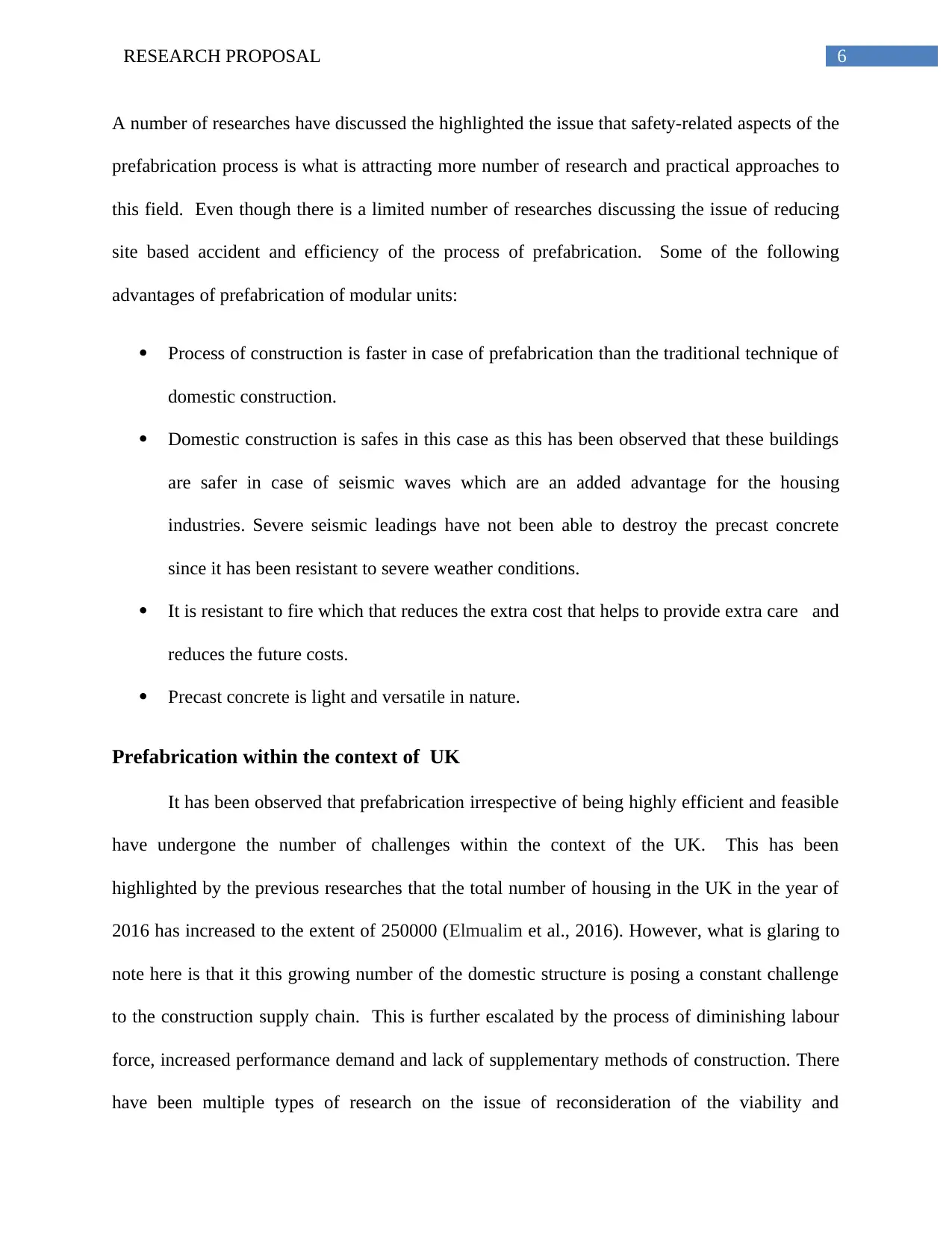
6RESEARCH PROPOSAL
A number of researches have discussed the highlighted the issue that safety-related aspects of the
prefabrication process is what is attracting more number of research and practical approaches to
this field. Even though there is a limited number of researches discussing the issue of reducing
site based accident and efficiency of the process of prefabrication. Some of the following
advantages of prefabrication of modular units:
Process of construction is faster in case of prefabrication than the traditional technique of
domestic construction.
Domestic construction is safes in this case as this has been observed that these buildings
are safer in case of seismic waves which are an added advantage for the housing
industries. Severe seismic leadings have not been able to destroy the precast concrete
since it has been resistant to severe weather conditions.
It is resistant to fire which that reduces the extra cost that helps to provide extra care and
reduces the future costs.
Precast concrete is light and versatile in nature.
Prefabrication within the context of UK
It has been observed that prefabrication irrespective of being highly efficient and feasible
have undergone the number of challenges within the context of the UK. This has been
highlighted by the previous researches that the total number of housing in the UK in the year of
2016 has increased to the extent of 250000 (Elmualim et al., 2016). However, what is glaring to
note here is that it this growing number of the domestic structure is posing a constant challenge
to the construction supply chain. This is further escalated by the process of diminishing labour
force, increased performance demand and lack of supplementary methods of construction. There
have been multiple types of research on the issue of reconsideration of the viability and
A number of researches have discussed the highlighted the issue that safety-related aspects of the
prefabrication process is what is attracting more number of research and practical approaches to
this field. Even though there is a limited number of researches discussing the issue of reducing
site based accident and efficiency of the process of prefabrication. Some of the following
advantages of prefabrication of modular units:
Process of construction is faster in case of prefabrication than the traditional technique of
domestic construction.
Domestic construction is safes in this case as this has been observed that these buildings
are safer in case of seismic waves which are an added advantage for the housing
industries. Severe seismic leadings have not been able to destroy the precast concrete
since it has been resistant to severe weather conditions.
It is resistant to fire which that reduces the extra cost that helps to provide extra care and
reduces the future costs.
Precast concrete is light and versatile in nature.
Prefabrication within the context of UK
It has been observed that prefabrication irrespective of being highly efficient and feasible
have undergone the number of challenges within the context of the UK. This has been
highlighted by the previous researches that the total number of housing in the UK in the year of
2016 has increased to the extent of 250000 (Elmualim et al., 2016). However, what is glaring to
note here is that it this growing number of the domestic structure is posing a constant challenge
to the construction supply chain. This is further escalated by the process of diminishing labour
force, increased performance demand and lack of supplementary methods of construction. There
have been multiple types of research on the issue of reconsideration of the viability and
Paraphrase This Document
Need a fresh take? Get an instant paraphrase of this document with our AI Paraphraser
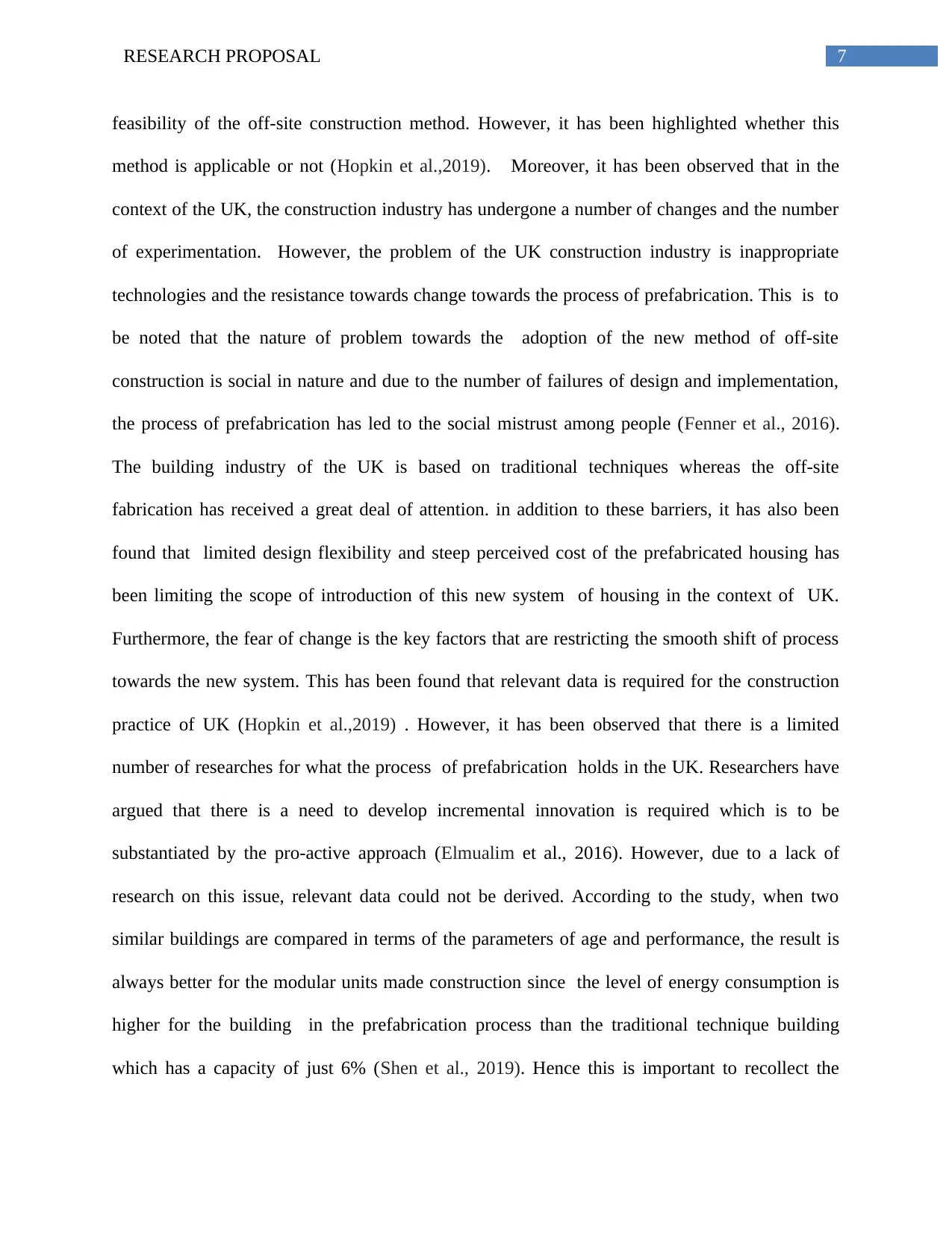
7RESEARCH PROPOSAL
feasibility of the off-site construction method. However, it has been highlighted whether this
method is applicable or not (Hopkin et al.,2019). Moreover, it has been observed that in the
context of the UK, the construction industry has undergone a number of changes and the number
of experimentation. However, the problem of the UK construction industry is inappropriate
technologies and the resistance towards change towards the process of prefabrication. This is to
be noted that the nature of problem towards the adoption of the new method of off-site
construction is social in nature and due to the number of failures of design and implementation,
the process of prefabrication has led to the social mistrust among people (Fenner et al., 2016).
The building industry of the UK is based on traditional techniques whereas the off-site
fabrication has received a great deal of attention. in addition to these barriers, it has also been
found that limited design flexibility and steep perceived cost of the prefabricated housing has
been limiting the scope of introduction of this new system of housing in the context of UK.
Furthermore, the fear of change is the key factors that are restricting the smooth shift of process
towards the new system. This has been found that relevant data is required for the construction
practice of UK (Hopkin et al.,2019) . However, it has been observed that there is a limited
number of researches for what the process of prefabrication holds in the UK. Researchers have
argued that there is a need to develop incremental innovation is required which is to be
substantiated by the pro-active approach (Elmualim et al., 2016). However, due to a lack of
research on this issue, relevant data could not be derived. According to the study, when two
similar buildings are compared in terms of the parameters of age and performance, the result is
always better for the modular units made construction since the level of energy consumption is
higher for the building in the prefabrication process than the traditional technique building
which has a capacity of just 6% (Shen et al., 2019). Hence this is important to recollect the
feasibility of the off-site construction method. However, it has been highlighted whether this
method is applicable or not (Hopkin et al.,2019). Moreover, it has been observed that in the
context of the UK, the construction industry has undergone a number of changes and the number
of experimentation. However, the problem of the UK construction industry is inappropriate
technologies and the resistance towards change towards the process of prefabrication. This is to
be noted that the nature of problem towards the adoption of the new method of off-site
construction is social in nature and due to the number of failures of design and implementation,
the process of prefabrication has led to the social mistrust among people (Fenner et al., 2016).
The building industry of the UK is based on traditional techniques whereas the off-site
fabrication has received a great deal of attention. in addition to these barriers, it has also been
found that limited design flexibility and steep perceived cost of the prefabricated housing has
been limiting the scope of introduction of this new system of housing in the context of UK.
Furthermore, the fear of change is the key factors that are restricting the smooth shift of process
towards the new system. This has been found that relevant data is required for the construction
practice of UK (Hopkin et al.,2019) . However, it has been observed that there is a limited
number of researches for what the process of prefabrication holds in the UK. Researchers have
argued that there is a need to develop incremental innovation is required which is to be
substantiated by the pro-active approach (Elmualim et al., 2016). However, due to a lack of
research on this issue, relevant data could not be derived. According to the study, when two
similar buildings are compared in terms of the parameters of age and performance, the result is
always better for the modular units made construction since the level of energy consumption is
higher for the building in the prefabrication process than the traditional technique building
which has a capacity of just 6% (Shen et al., 2019). Hence this is important to recollect the
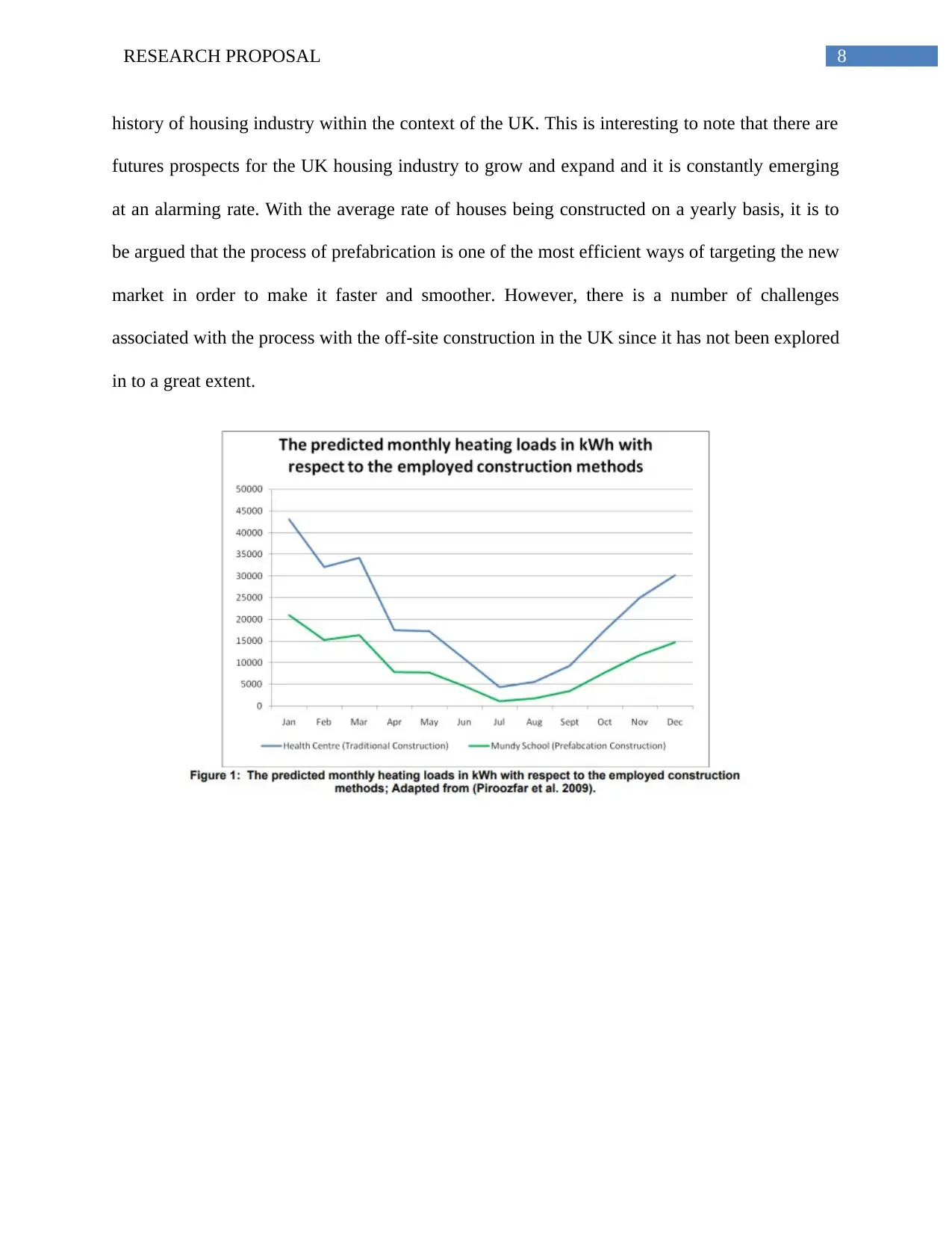
8RESEARCH PROPOSAL
history of housing industry within the context of the UK. This is interesting to note that there are
futures prospects for the UK housing industry to grow and expand and it is constantly emerging
at an alarming rate. With the average rate of houses being constructed on a yearly basis, it is to
be argued that the process of prefabrication is one of the most efficient ways of targeting the new
market in order to make it faster and smoother. However, there is a number of challenges
associated with the process with the off-site construction in the UK since it has not been explored
in to a great extent.
history of housing industry within the context of the UK. This is interesting to note that there are
futures prospects for the UK housing industry to grow and expand and it is constantly emerging
at an alarming rate. With the average rate of houses being constructed on a yearly basis, it is to
be argued that the process of prefabrication is one of the most efficient ways of targeting the new
market in order to make it faster and smoother. However, there is a number of challenges
associated with the process with the off-site construction in the UK since it has not been explored
in to a great extent.
⊘ This is a preview!⊘
Do you want full access?
Subscribe today to unlock all pages.

Trusted by 1+ million students worldwide
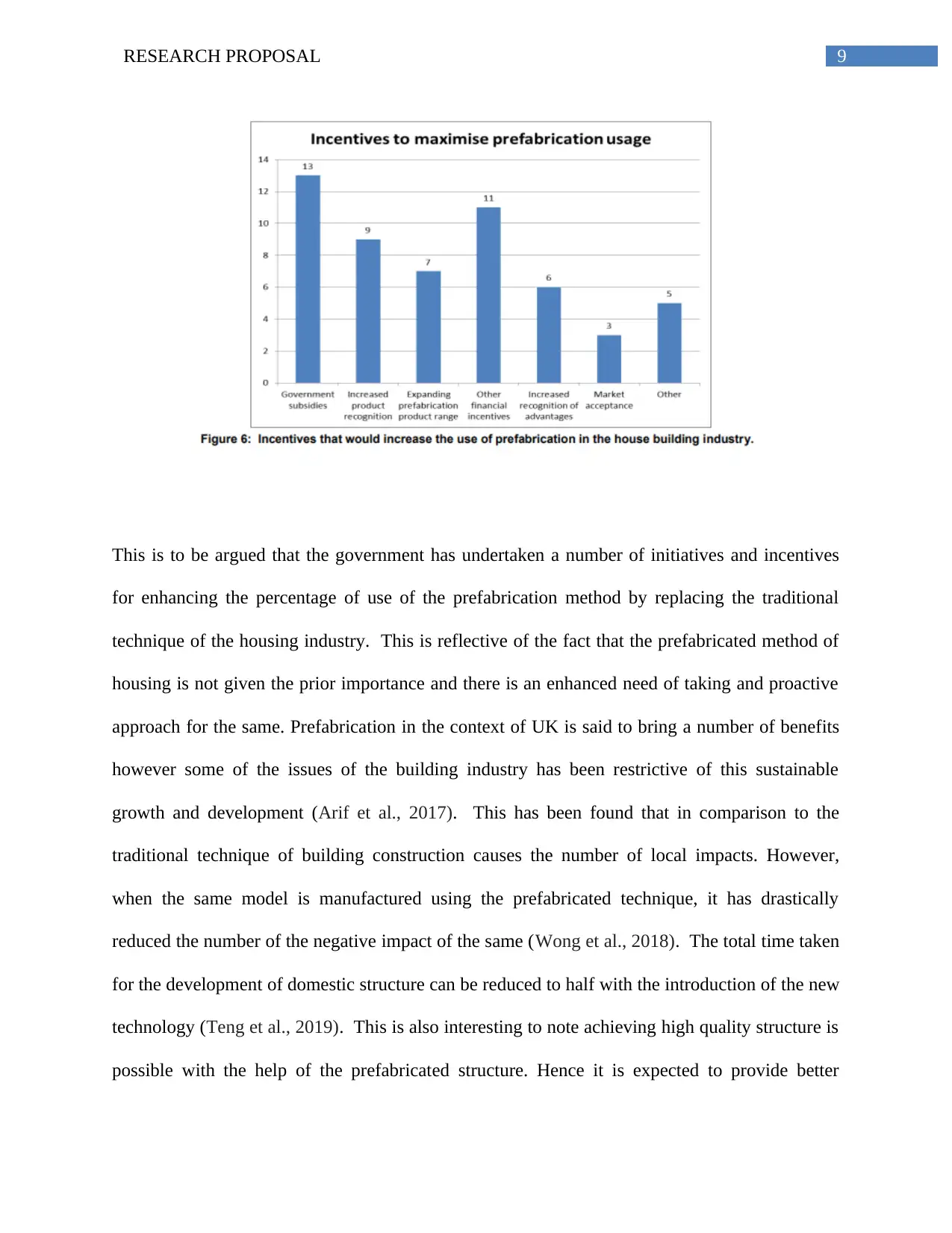
9RESEARCH PROPOSAL
This is to be argued that the government has undertaken a number of initiatives and incentives
for enhancing the percentage of use of the prefabrication method by replacing the traditional
technique of the housing industry. This is reflective of the fact that the prefabricated method of
housing is not given the prior importance and there is an enhanced need of taking and proactive
approach for the same. Prefabrication in the context of UK is said to bring a number of benefits
however some of the issues of the building industry has been restrictive of this sustainable
growth and development (Arif et al., 2017). This has been found that in comparison to the
traditional technique of building construction causes the number of local impacts. However,
when the same model is manufactured using the prefabricated technique, it has drastically
reduced the number of the negative impact of the same (Wong et al., 2018). The total time taken
for the development of domestic structure can be reduced to half with the introduction of the new
technology (Teng et al., 2019). This is also interesting to note achieving high quality structure is
possible with the help of the prefabricated structure. Hence it is expected to provide better
This is to be argued that the government has undertaken a number of initiatives and incentives
for enhancing the percentage of use of the prefabrication method by replacing the traditional
technique of the housing industry. This is reflective of the fact that the prefabricated method of
housing is not given the prior importance and there is an enhanced need of taking and proactive
approach for the same. Prefabrication in the context of UK is said to bring a number of benefits
however some of the issues of the building industry has been restrictive of this sustainable
growth and development (Arif et al., 2017). This has been found that in comparison to the
traditional technique of building construction causes the number of local impacts. However,
when the same model is manufactured using the prefabricated technique, it has drastically
reduced the number of the negative impact of the same (Wong et al., 2018). The total time taken
for the development of domestic structure can be reduced to half with the introduction of the new
technology (Teng et al., 2019). This is also interesting to note achieving high quality structure is
possible with the help of the prefabricated structure. Hence it is expected to provide better
Paraphrase This Document
Need a fresh take? Get an instant paraphrase of this document with our AI Paraphraser
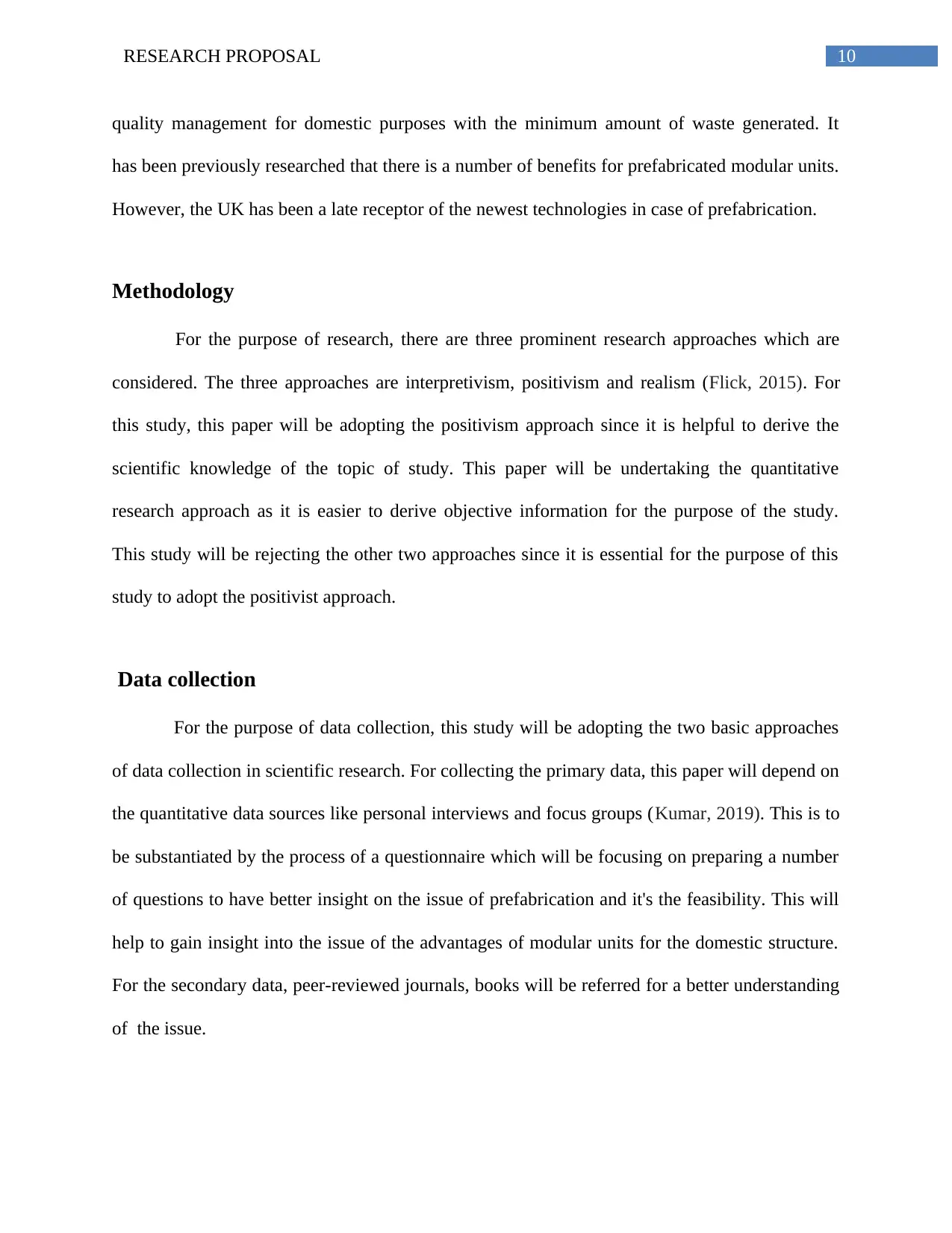
10RESEARCH PROPOSAL
quality management for domestic purposes with the minimum amount of waste generated. It
has been previously researched that there is a number of benefits for prefabricated modular units.
However, the UK has been a late receptor of the newest technologies in case of prefabrication.
Methodology
For the purpose of research, there are three prominent research approaches which are
considered. The three approaches are interpretivism, positivism and realism (Flick, 2015). For
this study, this paper will be adopting the positivism approach since it is helpful to derive the
scientific knowledge of the topic of study. This paper will be undertaking the quantitative
research approach as it is easier to derive objective information for the purpose of the study.
This study will be rejecting the other two approaches since it is essential for the purpose of this
study to adopt the positivist approach.
Data collection
For the purpose of data collection, this study will be adopting the two basic approaches
of data collection in scientific research. For collecting the primary data, this paper will depend on
the quantitative data sources like personal interviews and focus groups (Kumar, 2019). This is to
be substantiated by the process of a questionnaire which will be focusing on preparing a number
of questions to have better insight on the issue of prefabrication and it's the feasibility. This will
help to gain insight into the issue of the advantages of modular units for the domestic structure.
For the secondary data, peer-reviewed journals, books will be referred for a better understanding
of the issue.
quality management for domestic purposes with the minimum amount of waste generated. It
has been previously researched that there is a number of benefits for prefabricated modular units.
However, the UK has been a late receptor of the newest technologies in case of prefabrication.
Methodology
For the purpose of research, there are three prominent research approaches which are
considered. The three approaches are interpretivism, positivism and realism (Flick, 2015). For
this study, this paper will be adopting the positivism approach since it is helpful to derive the
scientific knowledge of the topic of study. This paper will be undertaking the quantitative
research approach as it is easier to derive objective information for the purpose of the study.
This study will be rejecting the other two approaches since it is essential for the purpose of this
study to adopt the positivist approach.
Data collection
For the purpose of data collection, this study will be adopting the two basic approaches
of data collection in scientific research. For collecting the primary data, this paper will depend on
the quantitative data sources like personal interviews and focus groups (Kumar, 2019). This is to
be substantiated by the process of a questionnaire which will be focusing on preparing a number
of questions to have better insight on the issue of prefabrication and it's the feasibility. This will
help to gain insight into the issue of the advantages of modular units for the domestic structure.
For the secondary data, peer-reviewed journals, books will be referred for a better understanding
of the issue.
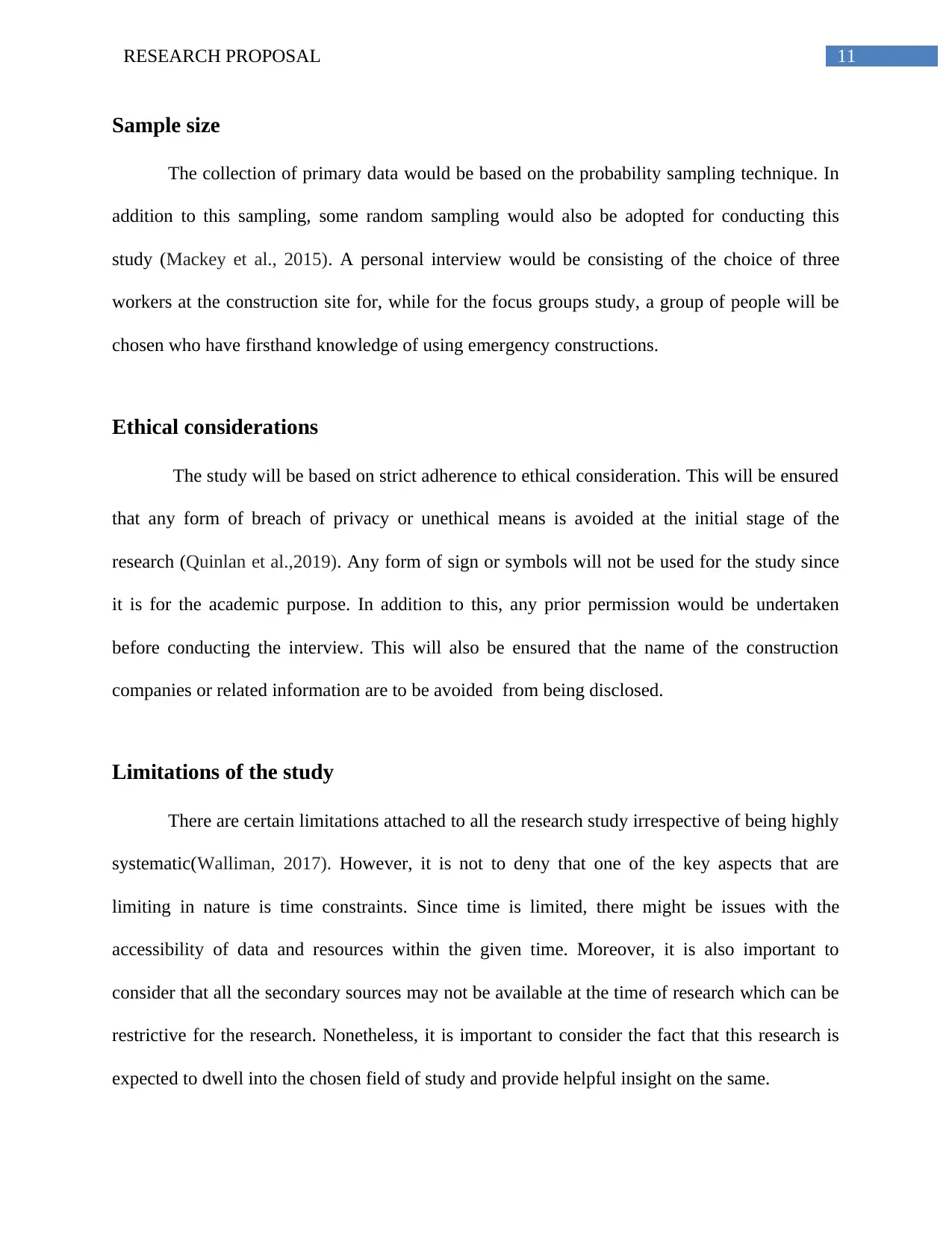
11RESEARCH PROPOSAL
Sample size
The collection of primary data would be based on the probability sampling technique. In
addition to this sampling, some random sampling would also be adopted for conducting this
study (Mackey et al., 2015). A personal interview would be consisting of the choice of three
workers at the construction site for, while for the focus groups study, a group of people will be
chosen who have firsthand knowledge of using emergency constructions.
Ethical considerations
The study will be based on strict adherence to ethical consideration. This will be ensured
that any form of breach of privacy or unethical means is avoided at the initial stage of the
research (Quinlan et al.,2019). Any form of sign or symbols will not be used for the study since
it is for the academic purpose. In addition to this, any prior permission would be undertaken
before conducting the interview. This will also be ensured that the name of the construction
companies or related information are to be avoided from being disclosed.
Limitations of the study
There are certain limitations attached to all the research study irrespective of being highly
systematic(Walliman, 2017). However, it is not to deny that one of the key aspects that are
limiting in nature is time constraints. Since time is limited, there might be issues with the
accessibility of data and resources within the given time. Moreover, it is also important to
consider that all the secondary sources may not be available at the time of research which can be
restrictive for the research. Nonetheless, it is important to consider the fact that this research is
expected to dwell into the chosen field of study and provide helpful insight on the same.
Sample size
The collection of primary data would be based on the probability sampling technique. In
addition to this sampling, some random sampling would also be adopted for conducting this
study (Mackey et al., 2015). A personal interview would be consisting of the choice of three
workers at the construction site for, while for the focus groups study, a group of people will be
chosen who have firsthand knowledge of using emergency constructions.
Ethical considerations
The study will be based on strict adherence to ethical consideration. This will be ensured
that any form of breach of privacy or unethical means is avoided at the initial stage of the
research (Quinlan et al.,2019). Any form of sign or symbols will not be used for the study since
it is for the academic purpose. In addition to this, any prior permission would be undertaken
before conducting the interview. This will also be ensured that the name of the construction
companies or related information are to be avoided from being disclosed.
Limitations of the study
There are certain limitations attached to all the research study irrespective of being highly
systematic(Walliman, 2017). However, it is not to deny that one of the key aspects that are
limiting in nature is time constraints. Since time is limited, there might be issues with the
accessibility of data and resources within the given time. Moreover, it is also important to
consider that all the secondary sources may not be available at the time of research which can be
restrictive for the research. Nonetheless, it is important to consider the fact that this research is
expected to dwell into the chosen field of study and provide helpful insight on the same.
⊘ This is a preview!⊘
Do you want full access?
Subscribe today to unlock all pages.

Trusted by 1+ million students worldwide
1 out of 17
Related Documents
Your All-in-One AI-Powered Toolkit for Academic Success.
+13062052269
info@desklib.com
Available 24*7 on WhatsApp / Email
![[object Object]](/_next/static/media/star-bottom.7253800d.svg)
Unlock your academic potential
Copyright © 2020–2025 A2Z Services. All Rights Reserved. Developed and managed by ZUCOL.





